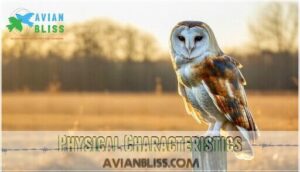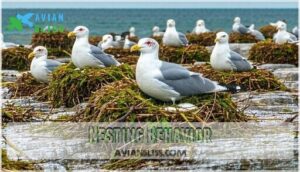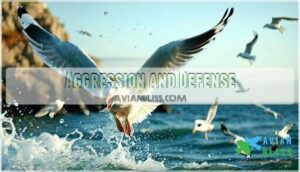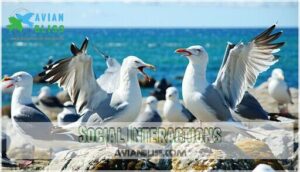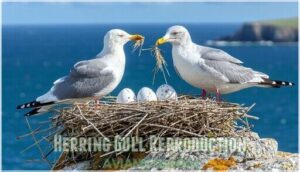This site is supported by our readers. We may earn a commission, at no cost to you, if you purchase through links.

These clever seabirds measure 22-26 inches with wingspans reaching 58 inches.
They’re master scavengers who’ll steal your sandwich as easily as they catch fish, and they thrive in coastal areas, beaches, and cities, adapting to whatever food sources they find.
They nest in colonies on cliffs, rooftops, or islands from April through August, and their loud calls and aggressive behavior around food make them unmistakable.
These opportunistic feeders eat everything from fish and crabs to garbage and other birds’ eggs, making them one of nature’s most successful survivors.
Table Of Contents
- Key Takeaways
- Herring Gull Identification
- Herring Gull Behavior
- Herring Gull Habitat
- Herring Gull Diet and Nutrition
- Herring Gull Reproduction
- Frequently Asked Questions (FAQs)
- Where do Herring Gulls live?
- Are Herring Gulls aggressive?
- How do you identify a herring gull?
- Are herring gulls in the US?
- What is the difference between a herring gull and a common gull?
- Are herring gulls aggressive?
- Where does the herring gull live?
- How long do herring gulls typically live?
- Can herring gulls recognize individual human faces?
- Do herring gulls migrate? If so, how far?
- Conclusion
Key Takeaways
- You’ll identify herring gulls by their gray wings, white bodies, and bright yellow beaks with distinctive red spots – these physical features, combined with their 22-26 inch size and pink legs, make them easy to distinguish from other gull species.
- You’re dealing with aggressive, opportunistic feeders who’ll steal your food without hesitation – they’re master scavengers that adapt their diet from fish and crabs to garbage and human scraps, making them incredibly successful survivors.
- You’ll find them thriving in both coastal and urban environments year-round – these adaptable birds nest in colonies on cliffs, rooftops, or islands and have mastered city life by exploiting human food sources.
- You’ll witness complex social behaviors during their April-August breeding season – both parents share nest-building, incubation, and chick-rearing duties while defending their territory through coordinated aggressive displays and calls.
Herring Gull Identification
You’ll find identifying herring gulls easier once you know their key features and size.
These large, robust gulls have distinctive yellow bills with red spots and can be tricky to separate from similar species without practice, which makes understanding their size crucial.
Physical Characteristics
You’ll recognize herring gulls by their impressive size—larger than ring-billed gulls but smaller than great black-backed gulls.
These robust birds showcase distinctive features that make identification straightforward.
Key Physical Features:
- Size Comparison: 22-26 inches long with barrel-chested build
- Bill Morphology: Stout yellow bill with red spot on lower mandible
- Leg Coloration: Pink legs at all ages distinguish from yellow-legged species
- Wing Structure: Broad wings with black wingtips featuring white mirrors
- Bird Plumage: Pale gray upperparts contrast with white head and underparts
Plumage Variations
You’ll notice herring gull plumage changes dramatically through their four-year journey to adult plumage.
Juveniles start with mottled brown and white patterns, gradually lightening each year.
Adult plumage features pale gray backs and wings with crisp black wingtips, and winter markings add dusky streaking on the head and neck.
Regional differences and hybrid variations can create confusing bird identification challenges.
Distinguishing Features
After looking at plumage, there’s more to herring gull identification than feathers alone.
Get a leg up by checking for unique traits that set these birds apart:
- Bright yellow bill with a red spot (Bill Markings)
- Pinkish legs (Leg Color)
- Barrel-chested, broad wings (Body Size, Wing Patterns)
- Pale eye ring (Eye Color)
- Pale gray back and wings
The key characteristics to look for include a combination of these features to accurately identify a herring gull, with a focus on unique traits.
Juvenile and Adult Differences
Juvenile herring gulls look completely different from their sleek adult counterparts.
Young birds sport mottled brown and white plumage that gradually lightens over four years.
Their bills start dark and slowly develop the bright yellow adult coloration with that distinctive red spot.
Juvenile leg color ranges from pink to dull yellow, while adults show consistent pink legs.
Eye color also transforms from dark brown in juveniles to pale yellow in mature birds, creating a striking identification difference you’ll notice immediately.
Paying attention to plumage and coloration is key to distinguishing them, using physical characteristics for accurate identification.
Herring Gull Behavior
You’ll notice herring gulls exhibit complex behaviors that go far beyond simple scavenging, from their strategic feeding techniques to their intricate social hierarchies.
These adaptable birds demonstrate remarkable intelligence in their daily interactions, whether they’re competing for prime nesting spots or working together in feeding flocks.
Feeding Behavior
You’ll discover that herring gulls employ remarkably adaptable foraging tactics to secure food sources.
These opportunistic feeders switch between marine diet preferences and scavenging habits based on availability, demonstrating flexible predatory behavior that guarantees survival.
- Marine hunting – Dive for fish, mollusks, and crustaceans in shallow waters
- Opportunistic feeding – Snatch human food scraps from beaches and parking lots
- Scavenging behavior – Pick through garbage dumps and fishing boat discards
- Diet variation – Adjust gull diet seasonally based on prey abundance
Nesting Behavior
During breeding season, herring gull pairs select nest sites within colonies that can house thousands of birds.
They’ll gather seaweed, grass, and feathers to build their shallow cup-shaped homes.
Colony dynamics influence territory size, typically 1.5-3 meters around each nest.
Both parents share nest construction duties before egg laying begins, creating safe spaces for chick development.
Aggression and Defense
You’ll witness herring gulls transform into fierce defenders when protecting their territory and young.
These seabirds employ multiple aggressive tactics to secure resources and ward off threats through strategic positioning and intimidation displays.
Key defensive behaviors include:
- Territorial Disputes – Bill jabbing and "choking" displays establish boundaries
- Chick Defense – Coordinated mobbing attacks target nest intruders
- Predator Evasion – Projectile vomiting and defecation deter threats
- Intraspecies Aggression – Adults dominate juveniles at prime feeding spots
- Scavenging Competition – Food mugging and chase-attacks secure meals
During nesting season, both parents share incubation responsibilities.
Social Interactions
When you observe herring gulls together, you’ll notice their complex social communication through calls, postures, and territorial disputes.
These birds form tight-knit breeding colonies where social hierarchy determines access to prime nesting spots.
Pair bonding strengthens through cooperative hunting and shared parental duties.
Within the flock, bird behavior reveals intricate colony dynamics that help maintain order during crowded breeding seasons, and understanding these interactions reveals how flocking offers safety from predators, highlighting the importance of flocking behavior.
Herring Gull Habitat
You’ll find herring gulls thriving in diverse environments from rocky coastlines to bustling city centers.
These adaptable birds make themselves at home wherever food and suitable nesting spots meet their needs, with complete concepts of adaptability being key.
Coastal Areas and Beaches
You’ll find herring gulls thriving along sandy beaches and rocky shorelines where Beach Ecosystems provide abundant food sources.
These coastal birds adapt remarkably to Shoreline Changes, whether natural or caused by Human Impact.
To manage gull presence effectively, consider using proven deterrent methods.
Their presence in coastal habitats reflects the complex Gull-Environment Interaction that shapes marine environments, and understanding their role supports Coastal Conservation efforts protecting essential coastal ecology.
Urban Settings and Human Activity
You’ll spot herring gulls thriving in urban environments where they’ve mastered city life.
These adaptable birds exploit garbage dumps and urban waterfronts for easy meals. Their Food Scavenging skills help them read human behavior to locate snacks.
City Nesting on rooftops and buildings has increased dramatically.
Urban Adaptation creates conflicts requiring Gull Management strategies in human-dominated environments. This is partly due to their reliance on kleptoparasitism as foraging.
Breeding and Nesting Sites
You’ll find herring gulls choosing their colony locations with remarkable care. These smart birds often form colonies on isolated islands, barrier beaches, and marshy hummocks, which are safe from terrestrial predators.
Gull colonies offer protection and community bonds that make seabird nesting successful. To further enhance nesting, consider using a gull nesting platform.
- Rocky coastal cliffs provide elevation and predator protection
- Urban rooftops serve as modern nesting alternatives
- Grassy islands create perfect nest materials within reach
These gull habitat preferences show parental roles already beginning before egg laying starts. The choice of nesting site is crucial for the success of the colony, and herring gulls take this decision with remarkable care.
Migration Patterns
Herring gulls’ migration patterns reveal fascinating bird behavior across diverse bird habitats.
These birds follow coastal routes that stretch 30% longer than direct paths, prioritizing familiar territories over efficiency.
Migration Characteristics
| Aspect | Details |
|---|---|
| Migration Triggers | Seasonal changes, food availability |
| Distance Traveled | Short to medium-distance migrants |
| Breeding Grounds | Coastal islands, Great Lakes region |
| Wintering Areas | Southern coasts, offshore waters |
Young birds migrate farther than adults, with coastal breeders often staying nearby while inland populations head to milder climates.
Bird migration timing varies – pairs form in spring, and bird distribution shifts as immature gulls venture south even from coastal breeding grounds.
They navigate using visual landmarks like coastlines and rivers.
Herring Gull Diet and Nutrition
You’ll discover that herring gulls are opportunistic feeders with remarkably diverse diets that change based on location and season.
These adaptable birds consume everything from fresh fish and marine invertebrates to human garbage and even other birds’ eggs, making them highly diverse in their feeding habits.
Fish and Seafood
You’ll often watch these gulls snatch fish straight from the water’s surface with impressive precision.
Their seafood consumption includes small fish like sardines, anchovies, and herring, plus crabs, mussels, and marine worms.
This feeding behavior positions them as key players in marine ecosystems, connecting different levels of the food chain.
Their prey species selection impacts local fishing areas, where herring gulls compete with commercial operations for the same marine life resources.
They also have specific preferences in seafood, which is a crucial aspect of their feeding behavior.
Carrion and Refuse
Next to fish and seafood, you’ll notice these birds are pros at Urban scavenging. Their diet shifts with opportunity—landfill feeding is the new normal.
Herring gulls adapt quickly, making human refuse part of their routine. This makes them masters of waste management, but also potential disease vectors.
- Rummaging trash
- Feeding on roadkill
- Sampling leftovers
- Dumpster diving
- Picking at compost, which showcases their ability to thrive in various environments, including those involving human refuse.
Eggs and Chicks
Curious about what happens after a gull lays eggs? You’ll notice their egg coloration ranges from buff to olive with dark blotches—perfect camouflage.
The incubation period lasts around 28 days, with both parents sharing duties. Chicks hatch and rely on parental regurgitation for food.
Fledging dependence runs high; young birds need support until they’re strong enough to fly independently.
Foraging Strategies
You’ll find herring gulls master several foraging strategies that make them incredibly successful hunters and scavengers.
These adaptable birds switch between techniques based on available opportunities and environmental conditions.
Key foraging approaches include:
- Prey Identification – Spotting fish, crabs, and marine invertebrates from above before diving
- Scavenging Tactics – Raiding garbage bins, following fishing boats, and cleaning up beach debris
- Cooperative Hunting – Joining flocks to overwhelm prey or share information about food sources
- Stealing Food – Harassing other birds until they drop their catch, then swooping in quickly
Their omnivorous, adaptable diet helps herring gulls thrive in diverse environments from wild coastlines to busy urban centers.
Herring Gull Reproduction
You’ll notice herring gulls work together to build nests, often choosing high ground or safe spots near water.
Both parents share the job, from laying a few speckled eggs to feeding hungry chicks by the beakful.
Nest Placement and Description
Herring gulls show strong Site Fidelity, returning to familiar Colony Locations year after year.
You’ll find their nesting colonies on coastal cliffs, islands, and even urban rooftops where Nest Elevation provides safety from predators.
| Nest Materials | Colony Location | Nest Construction |
|---|---|---|
| Seaweed, grass, feathers | Coastal cliffs, islands | Shallow ground scrape |
| Debris, vegetation | Urban buildings, dunes | Lined with soft materials |
| Sticks, plastic waste | Lake islands, marshes | Built by both parents |
These resourceful birds adapt their nesting choices to available materials and terrain.
Understanding their choices involves observing how environmental factors impact nesting success.
Incubation and Chick Rearing
Once eggs are laid, both parents share incubation duties for 28-30 days.
The buff to olive eggs, blotched with dark markings, require constant attention. You’ll witness dedicated teamwork as parents alternate warming their clutch.
Here’s what makes their chick-rearing remarkable:
- Synchronized hatching – Eggs hatch at 2-day intervals, creating staggered chick ages
- Regurgitation feeding – Chicks peck the red spot on parents’ bills to trigger meals
- Semi-precocial development – Young leave the nest within days but stay nearby
- Extended dependency – Chicks remain with parents long after their first flight attempts
Parental Care and Fledging
After hatching, herring gull parents share feeding duties through regurgitation feeding.
You’ll see chicks peck the red spot on their parent’s bill to trigger meals.
The nestling period lasts about six weeks before fledgling dependence begins.
Post-fledging care continues for months as young birds learn essential survival skills through cooperative breeding efforts.
Breeding Seasons and Colony Formation
Throughout spring’s awakening, these adaptable seabirds gather in bustling colonies from April to June.
Colony nesting begins when pairs form around mid-March, with males establishing territories through elaborate mating rituals.
You’ll witness remarkable breeding success as both parents share parental roles during the 30-day incubation period.
Chick development progresses rapidly in these protective community settings, where herring gull families thrive together.
Frequently Asked Questions (FAQs)
Where do Herring Gulls live?
You’ll find these adaptable birds thriving along coastlines, beaches, marshes, and urban areas throughout the Northern Hemisphere.
They’re drawn to fishing docks, harbors, and anywhere humans gather, making them remarkably successful city dwellers.
Are Herring Gulls aggressive?
Yes, you’ll find herring gulls can be quite aggressive, especially during breeding season. They’ll defend their territory fiercely, steal food from other birds, and even harass people for snacks.
How do you identify a herring gull?
Look for a large gull with pale gray back, white body, and black wingtips with white spots.
You’ll notice its hefty yellow bill sporting a distinctive red spot, plus pink legs and pale yellow eyes.
Are herring gulls in the US?
Where there’s water, there’s a way" – and American Herring Gulls have found their way throughout the US.
You’ll spot them along both coasts, the Great Lakes, and inland waterways year-round, making them one of America’s most widespread gulls, as they follow the water to thrive.
What is the difference between a herring gull and a common gull?
These two bird species have distinct differences you’ll spot easily.
Common gulls appear like mini herring gulls with silver-grey backs but are much smaller with yellow legs.
While herring gulls sport pink legs and larger, more robust bills, they are clearly distinguishable from common gulls by these and other distinct characteristics.
Are herring gulls aggressive?
Like fortress guardians protecting their domain, these coastal birds display territorial aggression.
They exhibit high levels of aggression, particularly during breeding season and when competing for food.
You’ll notice they fiercely defend nests and boldly confront threats, exhibiting a strong instinct to protect their territory with aggression.
Where does the herring gull live?
You’ll find these adaptable birds thriving across coastal areas, beaches, marshes, and urban settings throughout the Northern Hemisphere.
They’re commonly spotted near fishing docks, harbors, and wherever human activity provides abundant food sources.
How long do herring gulls typically live?
You’ll often spot these savvy survivors for up to 15 to 20 years in the wild.
Life’s not all smooth sailing—predators, storms, and food shortages pose risks.
A lucky few might even reach 30, outliving expectations.
Can herring gulls recognize individual human faces?
Don’t blink—those sharp eyes just might remember you!
Some birds can spot people by faces, and herring gulls? Science shows they’ll often recognize individual humans, especially those who feed or disturb them.
You can’t fool a gull, especially if they are herring gulls that have been fed or disturbed by individual humans.
Do herring gulls migrate? If so, how far?
Yes, you’ll find herring gulls migrate seasonally. They travel mainly from August to October and February to April, ranging throughout North America and wintering as far south as Middle America.
Conclusion
Mastering herring gull identification transforms you into a seabird expert overnight!
You’ll never mistake these gray-winged opportunists for other gulls again.
Their yellow beaks, aggressive food-stealing tactics, and adaptability make them fascinating subjects.
Whether you’re watching them dive for fish or raid garbage cans, you now understand their remarkable survival skills.
Next time you visit the coast, you’ll appreciate these clever birds differently.
Your newfound knowledge turns every beach walk into an exciting herring gull spotting adventure.

